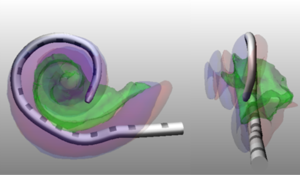Home » Supported Research » Computer-assisted, image-guided programming of cochlear implants
Computer-assisted, image-guided programming of cochlear implants
Title:
Computer-assisted, image-guided programming of cochlear implants
Project Number:
5R01DC014462-05
Contact PI/Project Lead:
Benoit Dawant
Award Organization:
National Institutes of Health
Abstract:
To date, over 320,000 hearing impaired individuals have received cochlear implants (CIs) in which an electrode array designed to substitute natural nerve stimulation by electrical stimulation is threaded into the cochlea. While speech understanding outcomes are typically good among CI users, even the best users complain that the fidelity of natural hearing is rarely reproduced. Additionally, a significant minority do poorl. Recently, we have developed a series of image processing algorithms that operate on CT images and permit for the first time to determine precisely the position of individual CI electrodes with respect to the nerves they activate. This will fundamentally change the postoperative management of CI recipients because it permits, also for the first time, the development of custom electrode programing strategies that are informed by objective imaging data. We have developed such an Image-Guided Cochlear Implant Programming (IGCIP) strategy and we have demonstrated that it can substantially and sometime dramatically improve hearing in long term CI users without requiring an additional surgical procedure. The success rate of our approach is also remarkable with the new setting being preferred 77% of the time by the 107 long term recipients who have participated in our ongoing study. To broaden patient access to this technology, we now propose to completely automate our algorithms and to develop software packages that will be useable by clinicians at the time and point of care. We also propose to conduct a large scale clinical validation both at our institution and at collaborating sites to discover factors that affect the performance of our method and further improve it.

